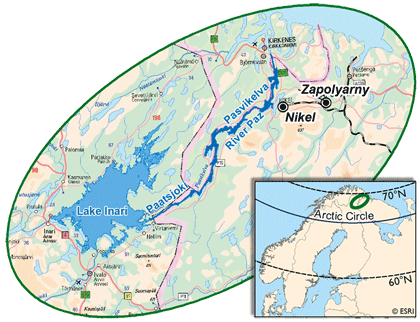Monitoring Programme
Long-term environmental monitoring programme for the border area
 The greatest factor influencing the environmental state of the border area of Finland, Norway and Russia is the Pechenganikel Mining and Metallurgical Combine in the Kola Peninsula producing copper, nickel and sulphuric acid.
The greatest factor influencing the environmental state of the border area of Finland, Norway and Russia is the Pechenganikel Mining and Metallurgical Combine in the Kola Peninsula producing copper, nickel and sulphuric acid.
The emissions of the combine contain very high quantities of sulphur dioxide and heavy metals, the majority of which are nickel and copper. The measures performed over the past few years and planned measures aimed at significantly reducing the combine emissions are expected to improve the state of the environment.
All three nations have their own monitoring programme for the Pasvik watercourse region which increases monitoring expenses. The national monitoring programmes have been established for monitoring on the national level, which means the measurement network is sparse and measurable parameters are deficient in producing comprehensive information on changes in the environmental state of the border area. The fragmentation of monitoring data for different sources complicates the effective utilization of results, and thereby the comprehensive conception of the state of the environment.
Based on an initiative proposed by the Finnish Norwegian Transboundary Water Commission and the support of the environmental authorities of the Murmansk region, a decision was made to develop a joint, long-term monitoring system to facilitate the effective observation of changes in the state of the environment. This monitoring programme was carried out within the Interreg IIIA Kolarctic project during the period 2003-2006 and developed further in the Kolarctic ENPI Programme in 2012-2014.
The programme is based on national monitoring in addition to the formulated recommendations made on the basis of new data produced by the project. In this way it is easier to take factors characteristic of the area into account, such as the changes in Pechenganikel emissions’ quantities and the consequent fluctuations in load levels. If the emissions of the area were to be reduced or cease completely as a result of the renewal of the Kola Peninsula mining and metallurgical industry, this programme also enables observation of the consequent changes to the environment.
The harmonized monitoring programme of these three nations was commissioned in 2007. The programme encompasses the monitoring of terrestrial ecosystems, air quality, deposition loading, water quality and aquatic ecosystems. A more comprehensive biological monitoring of aquatic ecosystems was planned in 2014 and it includes monitoring of phyto- and zooplankton, benthic diatoms and macroinvertebrates, aquatic macrophytes and fish communities. The monitored parameters vary between the monitoring sites.
In order to make the harmonization of monitoring successful, continuous quality control is performed and the reporting of findings is also combined. For the time being, it is only possible to implement the sub-areas of the programme that do not necessarily require extra funding.
Images: Lapin ELY
 The greatest factor influencing the environmental state of the border area of Finland, Norway and Russia is the Pechenganikel Mining and Metallurgical Combine in the Kola Peninsula producing copper, nickel and sulphuric acid.
The greatest factor influencing the environmental state of the border area of Finland, Norway and Russia is the Pechenganikel Mining and Metallurgical Combine in the Kola Peninsula producing copper, nickel and sulphuric acid. 